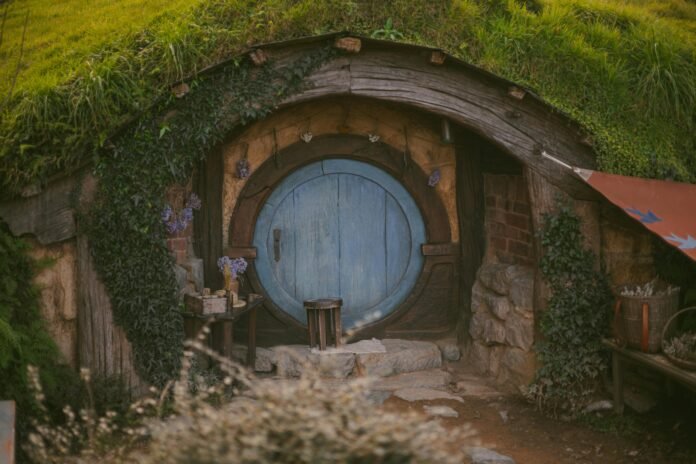Why Hobbit Houses Capture Our Imagination
There’s something magical about the idea of a hobbit house. For many people, it starts with J.R.R. Tolkien’s famous stories, The Hobbit and The Lord of the Rings. In those tales, hobbits lived in charming little dwellings built into the sides of hills. With their round doors, earthy roofs, and cozy interiors, these homes felt warm, welcoming, and deeply connected to nature. Even if you aren’t a fan of fantasy, there’s a good chance you’ve seen photos of these houses online or spotted them in films. And if you’re anything like me, you probably felt a little tug in your heart wishing you could step inside and stay forever.
But hobbit houses aren’t just part of fiction anymore. In the last decade, people all around the world have been inspired to build real-life hobbit homes. Some are small and simple, made as backyard projects. Others are full-sized residences, designed to be permanent family homes. There are even hobbit houses available on Airbnb for travelers who want a taste of Middle-earth magic.
What makes hobbit houses so fascinating is the way they blend fantasy with practicality. They’re whimsical, but they also have real benefits: energy efficiency, sustainability, and a natural connection to the land. In this article, we’ll take a deep dive into hobbit houses: where they came from, how they’re built, what they cost, and what it’s actually like to live in one.
The Origins of Hobbit Homes (Inspired by Tolkien)
The idea of hobbit houses comes directly from the imagination of J.R.R. Tolkien, the English writer who created Middle-earth. In his books, hobbits are peaceful, nature-loving folk who live in rural areas. Their homes are not castles or tall buildings but rather cozy dwellings built into hillsides. Tolkien described them as having round doors, low ceilings, and a very snug atmosphere.
When The Lord of the Rings movies came out in the early 2000s, the set designs brought these houses to life in New Zealand. The Hobbiton movie set in Matamata became an international attraction, and suddenly the whole world could see what a hobbit home might look like. People didn’t just admire the houses on screen—they wanted to live in them.
Interestingly, Tolkien himself was inspired by traditional architecture. In many parts of Europe, people have built earth-sheltered houses for centuries. These structures used the land as insulation, keeping homes cool in summer and warm in winter. Hobbit houses may feel fantastical, but they’re rooted in a very practical and ancient idea.
I still remember the first time I saw pictures of the Hobbiton set online. The round green doors almost looked alive, as if they were inviting you to step inside. The grass-covered roofs looked like part of the hillside, blending seamlessly with the environment. It struck me that these houses weren’t just beautiful; they represented a slower, more peaceful way of living. That’s something many of us long for in today’s busy world.
Key Features of Hobbit House Architecture
So what makes a hobbit house instantly recognizable? While no two hobbit homes are exactly alike, there are several design features that give them their charm.
1. The Famous Round Door
The most iconic feature of a hobbit house is its round door. This detail comes straight from Tolkien’s description, and it’s something that real-life builders often replicate. A circular entrance makes the house feel playful and different, almost like you’re stepping into another world.
From a practical point of view, round doors aren’t common, so they require custom carpentry. Some modern hobbit houses choose to keep traditional rectangular doors while still framing them with round facades for the aesthetic. Personally, I think the round door is worth the effort—it’s what makes the house feel magical.
2. Earth-Sheltered Design
Most hobbit houses are built into the side of a hill or covered with earth. This not only looks beautiful but also has practical benefits. The earth acts as natural insulation, keeping the home cool during hot weather and warm during cold seasons. It also helps reduce energy costs, which is one reason eco-conscious people are drawn to these designs.
When I once stayed in a small earth-sheltered cabin in northern Europe, I was amazed at how quiet it felt inside. The earth dampened outside noise, creating a peaceful retreat. I imagine hobbit houses offer a similar kind of calm.
3. Natural Materials
Hobbit houses often use wood, stone, and clay to create a natural look. The goal is to blend with the surrounding environment rather than stand out from it. Interiors usually feature exposed beams, stone fireplaces, and wooden furniture. The effect is rustic yet cozy, making you feel as if you’re part of the landscape.
4. Cozy Interiors
Inside a hobbit house, you’ll usually find warm, inviting spaces. Think low ceilings, circular windows, and lots of wooden details. Many hobbit houses include built-in furniture, like curved shelves or nooks. The style encourages people to slow down and enjoy their surroundings.
For me, the appeal of these interiors lies in their simplicity. They don’t scream luxury, but they radiate comfort. It’s the kind of place where you’d happily curl up with a book by the fire or share tea with friends.
5. Grass-Covered Roofs
A living roof is one of the most distinctive parts of a hobbit house. Covered with grass or plants, it allows the home to blend into the hillside. These roofs are not only beautiful but also help with insulation and stormwater management. They’re a prime example of how a whimsical design can also be practical.


